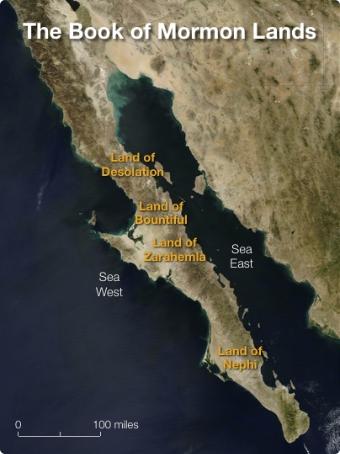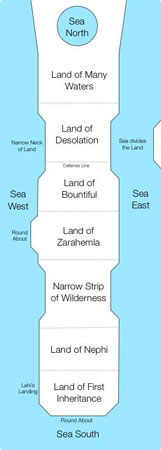Lynn Rosenvall & David Rosenvall – Baja / “Book of Mormon Evidence in the Baja Peninsula” by John P. Livingstone
The H38 Virus succeeded in placing the Sea North (Salton Sea) in place of the Sea East in their Land Northward; and the Sea South, south of the Land Southward.
Having an isolated Sea North does not work. The Mulekites came to the Land Northward via the Sea North/Ripliancum, which was connected to the Great Deep, (which they crossed to get there) which is impossible with their model.
The Sea South is only cited in reference to the Jaredite Land Northward. To make the Baja model work, they interpret “land round about” to mean the Sea South:
“Mormon in his description of the land of Nephi also includes a noteworthy phrase—’the regions round about’…The southern sea boundary of their land—possibly a ’round about’ shaped cape.”
The twisting of scripture is often employed by geography enthusiasts. This is how it actually reads in full:
And it came to pass that the king sent a proclamation throughout all the land, amongst all his people who were in all his land who were in all the regions round about which was bordering even to the sea, on the east and on the west, and which was divided from the land of Zarahemla by a narrow strip of wilderness, which ran from the sea east even to the sea west, and round about on the borders of the seashore, and the borders of the wilderness which was on the north by the land of Zarahemla, through the borders of Manti, by the head of the river Sidon, running from the east towards the west—and thus were the Lamanites and the Nephites divided. (Alma 22:27)
They misuse a second verse as well:
“This description of a circular land area is reinforced by the concept that the Nephites had ‘hemmed in the Lamanites on the south, that thereby they should have no more possession on the north’” (Alma 22:33).
The actual text:
32 And now, it was only the distance of a day and a half’s journey for a Nephite, on the line Bountiful and the land Desolation, from the east to the west sea; and thus the land of Nephi and the land of Zarahemla were nearly surrounded by water, there being a small neck of land between the land northward and the land southward.
33 And it came to pass that the Nephites had inhabited the land Bountiful, even from the east unto the west sea, and thus the Nephites in their wisdom, with their guards and their armies, had hemmed in the Lamanites on the south, that thereby they should have no more possession on the north, that they might not overrun the land northward. (Alma 22)
As can be seen, the “hemming in” occurred in the Land Bountiful just south of the “small neck of land” that led into the Land Northward. What was south of this line of fortification they made in the Land of Bountiful? Was it a body of water as they propose, even the Sea South?
No. South of the Land Bountiful was the Land of Zarahemla, Land of Nephi, the Lamanite Lands of Possession and the Land of First Inheritance. They were “hemmed in” by those Nephite lands, not a fictitious sea.
There is an irresistible tendency by some to claim that a sea existed south of the Land of First Inheritance since, “no one went there,” they surmise, “there must be nothing there.” There was something there – Native American tribes who Laman and Lemuel aligned with.
Nephi was told by God (2 Nephi 5:5) to go north, not because there was a sea south of the Land of Inheritance, but because He wanted them to merge with the Mulekites and then to inhabit Jaredite lands.
Ripliancum is the Sea North. The final Jaredite battle originated at the West Sea and they fought easterly AWAY from it. Then, they went north to Ripliancum, and from there they fled “southward (Ether 15:10).” Ripliancum is on the north, not west.
Regarding Salt Seas
The Rosenvalls prefer a modern dictionary to define the word “sea” instead of the scriptures:
But what is meant by the term “sea” when describing a body of water? The New Oxford American Dictionary defines a sea as “the expanse of salt water that covers most of the earth’s surface and surrounds its land masses.” The term “sea” is sometimes incorrectly used to describe a fresh water lake, for example, the Sea of Galilee, which today is more accurately called Lake Kinneret.
That is not correct. The Biblical use of the word “sea” in reference to an inland fresh water lake is indeed “sea:”
OT – “Even unto the edge of the sea of Chinnereth (Galilee) on the other side Jordan eastward. (Joshua 13:27)
NT – “Jesus went over the sea of Galilee, which is the sea of Tiberias.” (John 6:1; see Mark 1:16; Mark 7:31; Matthew 4:15,18; Matthew 15:29)
To buoy their approach, they try and claim that “many waters” means “salt water:”
“Obviously, the Book of Mormon people would have readily understood that the expansive sea they “beheld” from their camp along the Arabian sea coast, and called “Irreantum” or “many waters,” was salt water and not fresh water. Thus Nephi’s record appears to define “many waters” as a large body of sea water.”
Rosenvall(s), like many geography enthusiasts, confuse the expression of “many waters” for the name of a substance (salt water), or the identification of a certain body of water (near the Land Northward and Cumorah), while ignoring its use to describe something voluminous:
And it came to pass that when they were buried in the deep there was no water that could hurt them their vessels being tight like unto a dish, and also they were tight like unto the ark of Noah; therefore when they were encompassed about by many waters they did cry unto the Lord, and he did bring them forth again upon the top of the waters. (Ether 6:7)
Clearly “the deep” identifies the salt water ocean; and “many waters” was (as Nephi stated) merely an expression of volume. If the Rosenvalls wish to maintain their interpretation, they must apply it to the prophecies as well:
10 And it came to pass that I looked and beheld many waters; and they divided the Gentiles from the seed of my brethren.
12 And I looked and beheld a man among the Gentiles, who was separated from the seed of my brethren by the many waters; and I beheld the Spirit of God, that it came down and wrought upon the man; and he went forth upon the many waters, even unto the seed of my brethren, who were in the promised land.
13 And it came to pass that I beheld the Spirit of God, that it wrought upon other Gentiles; and they went forth out of captivity, upon the many waters.
29 And after these plain and precious things were taken away it goeth forth unto all the nations of the Gentiles; and after it goeth forth unto all the nations of the Gentiles, yea, even across the many waters which thou hast seen with the Gentiles which have gone forth out of captivity, thou seest—because of the many plain and precious things which have been taken out of the book, which were plain unto the understanding of the children of men, according to the plainness which is in the Lamb of God—because of these things which are taken away out of the gospel of the Lamb, an exceedingly great many do stumble, yea, insomuch that Satan hath great power over them. (1 Nephi 13)
Obviously 1 Nephi 13 is about America, the Puritans, the Pilgrims, the Colonists, the Colonial War, Great Britain, France, Spain, the American Indians, etc. and the Atlantic Ocean – not the Pacific!
The salt water oceans on the other hand are described as “the great deep:”
…he hath preserved me upon the waters of the great deep. (2 Nephi 4:20)
…bringing them across the great deep into the promised land; (Ether 7:27)
…our fathers brought across the great deep? (Ether 8:9)
This title however is never used to describe any bodies of water surrounding Book of Mormon lands. The “great deep” did not border Book of Mormon lands. Baja cannot be Book of Mormon lands.
Climate
The Rosenvalls spend an inordinate amount of time drawing connections between the climate of Israel and that of Baja. They fail to understand matching the climate of Israel has little relevance to identifying promises of the Book of Mormon, already fulfilled. For example, Nephi said they were led to a “better land.” The Rosenvalls fail to show how Baja is “better than” Israel. (2 Nephi 10:20)
Notable deficiencies: Why they consider this dry, rocky, desert area worthy to be called: “choice above all others”? Or where the “many rivers are?” Or how they “sent forth by way of shipping” for timber? Early in their modeling we encouraged them to abandon the Baja model due to its Land Northward and Spiritual Geography deficiencies, but so far they haven’t heeded the warning.
Few points of geography can be twisted or ignored, but a sea south and north of the “land choice above all others” are not one of them. Baja will never work, but it’s a fun place to visit.


